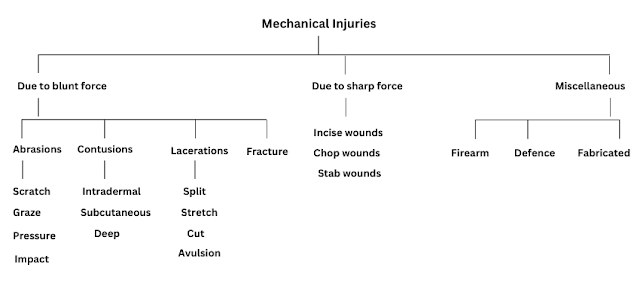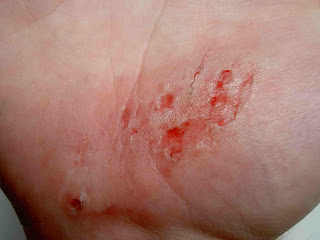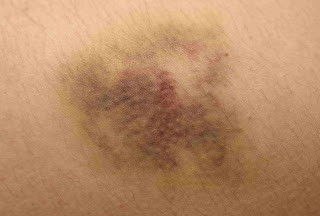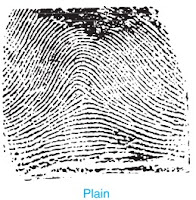Mechanical Injuries: Definition, Types and Factors Affecting
What are Mechanical Injuries?
Injuries that are produced by any kind of mechanical force like blunt, sharp objects, firearms, etc are known as mechanical injuries. Injuries are defined as any harm to any person in body, mind, reputation, or property.
Types of mechanical Injuries
(A) Blunt force mechanical injuries
Injuries caused by blunt force impact by objects like bat pipe, rod, etc are known as blunt force mechanical injuries. The injuries by blunt force produce abrasion, bruise, laceration, etc.
1. Abrasion
Injury caused by the removal of the superficial epithelial layer of skin (generally epidermis) by friction against the rough surface is called abrasion.
Following are the types of abrasion:
(a) Scratch/ Linear Abrasion
Linear abrasion is caused by a sharp or pointed object like a fingernail, thorn, or pin on the surface of the skin. It has some length but no significant width.
(b) Graze abrasion (sliding/scrape/grinding abrasion)
- Graze abrasion is caused by horizontal or tangential friction between the skin and the hard rough surface.
- They show uneven, longitudinal parallel lines which indicate the direction in which the force is applied.
- In this abrasion, the epidermis heaped up at the opposite end.
- They are generally seen in road traffic accidents.
(c) Pressure abrasion (Crushing/Friction abrasion)
Pressure abrasion is caused by direct impact or linear pressure of a rough object over the skin. In this abrasion, crushing of superficial layers of the epidermis takes place and the movement of the instrument is around 90° to the skin. For eg, Tire marks, teeth bite marks, etc.
(d) Imprint abrasion (Impact/Contact abrasion)
- Imprint abrasion is caused when the force is applied perpendicular to the skin.
- In this abrasion, the cuticle gets crusted at the point of impact and bears the imprint of the object.
- These abrasions are slightly depressed below the surface.
- U.V light may be used to visualize these abrasions that are not apparent with visible light.
2. Bruise/ Contusion
- A bruise is the extravasation of blood in the subcutaneous/ subepithelial tissues due to a rupture of the blood vessel.
- A lesion is observed through the intact skin as bluish purple discoloration and swelling in that area.
- It is done by the application of blunt force like sticks, iron-bar, whips, or chains.
Following are the types of bruises:
(a) Intradermal bruise
Bruise that lies in the immediate subepidermal layer. It is made by impact with a patterned object and hemorrhage is seen.
(b) Subcutaneous bruise
Bruise that lies in subcutaneous tissue, generally in the fatty layer, and the edges are blurred. It is caused by the application of a blunt object and the injury appears as dark red swelling.
(c) Deep Bruise
The bruise is caused by deeper bleeding to the subcutaneous tissue. It may take some hours to even 1-2 days to appear at the surface (delayed bruising). Therefore, one more examination is carried out after 24-48 hours of the first examination. IR photography may expose such bruises.
Factors affecting the bruise
(i) Type of tissue/site involved
- Soft tissues like the scrotum and eyelids develop large bruises even with little force.
- Bruising of the scalp is better felt than seen.
- Bruising is more marked on tissues overlying bone.
- In athletes, bruising is much less because of good muscle tone.
(ii) Age
Children and old people get bruised more easily due to softer tissue and delicate skin.
(iii) Gender
Women tend to get bruises more easily than men because tissues are more delicate and subcutaneous fat is more.
(iv) Color of skin
Bruising is more clearly seen in fair skin as compared to people having dark skin.
3. Laceration
A laceration is the tearing or splitting of skin, mucous membranes, and muscle caused by the application of blunt force. If the blunt force produces extensive bruising and laceration of deeper tissue, it is called crash injury.
Following are the type of lacerations:
(a) Split lacerations
It occurs when soft tissues are sandwiched between a hard unyielding deeper structure due to applying force. Common sites are the scalp, forehead, eyebrows, etc.
(b) Stretch lacerations
They are produced due to overstretching of the skin and subcutaneous tissue can cause lacerations with the flapping of the skin that indicates the direction of application of force. They are usually seen in cases like run over by motor vehicles.
(c) Avulsion or grinding compression
They are produced by a shearing force applied at a tangential angle to tear off a portion of the traumatized skin surface.
These are commonly seen in road traffic accidents where the rotating force of the wheel tears off the skin over a large area.
(d) Tears
Tearing of skin and subcutaneous tissue can occur from localized impact by some hard, irregular object like a car door handle, broken glass bottles, etc.
(e) Cut laceration
This occurs when a heavy sharp edged weapon causes a deep and wide cut over the body.
(B) Sharp force mechanical injuries
Injuries caused by sharp force impact like knife tip, broken glass, axe, etc are known as sharp force mechanical injuries. The injuries caused by sharp force are incised wounds, stab wounds, and chop wounds.
1. Incised wound (cut/slash/slice)
Incised wounds are caused by making a clean cut through the tissues (usually skin, subcutaneous tissues, and blood vessels) with a sharp-edged instrument. These cuts are more long than deep and they are produced by applying pressure and friction against the tissue with a knife, razor, or scalpel.
Characteristics of an incised wound
1. Margin
Edges are clean cut, well defined, and usually everted. The edges are free from contusions and abrasion.
2. Width/breadth
The width is greater than the edge of the weapon causing it due to retraction of the divided tissues.
3. Length
Length is greater than the width and the depth of the wound.
4. Shape
The incised wound is usually spindle-shaped due to greater retraction of the edges in the center.
5. Hemorrhage
As vessels are cut clean, hemorrhage is more.
2. Chop wounds
- Chop wounds are produced due to blows with the moderately sharp cutting edge of a heavy weapon like an axe.
- A chop wound is considered a combination of both blunt and sharp force injury.
- The weapon used as Hatchet, axe, saber, and meat clavers.
- Margins of chop wounds are sharp and may show abrasion, bruising, and some laceration with severe injury to the underlying organs.
3. Stab wounds
Stab wounds are produced due to the penetration of long narrow instruments having pointed ends into the body. They are deeper than their length and breadth. Weapons used are knives, broken bottles, scissors, daggers, screwdrivers, forks, etc.
Following are the types of stab wounds:
(a) Penetrating wound
Weapons enter the body cavity producing only one wound which is a wound of entry.
(b) Perforating wound
Weapon after entering from one side of the body will emerge out through the other side producing two wounds.
(i) Entry wounds
Through which the weapon enters the body. It is larger and with inverted edges.
(ii) Exit wounds
Through which the tip of the weapon emerges out of the body. It is usually smaller with everted edges.
Characteristics of stab wounds
1. Margins
Edges of the wound are clean cut, usually, no abrasion or bruising is seen. They are regular, sharp, and well-defined.
2. Length
Length is slightly less than the width of the weapon because of the stretching of the skin.
3. Breadth
It is more than the width of the blade due to gaping.
4. Depth
Depth is the main characteristic of the stab wound. But it is not safe to measure the depth of the wound using a probe because it may disturb the loose clot and may lead to fatal hemorrhage.
(C) Miscellaneous Mechanical Injuries
1. Firearm Injuries
Injuries caused by various firearms like pistols, rifles, revolvers, etc are known as firearm injuries. They cause entry and exit bullet wounds in the body.
2. Defense Injuries
Defense injuries are caused due to the immediate reaction of the victim against an attack. These are usually of two types.
(a) Active defense injuries
These injuries are produced when the victim tries to seize/snatch the weapon from an attacker. These injuries are usually located on the palms, fingers, and base of the thumb.
(b) Passive defense injuries
These are produced when the victim raises the hands or arms for protection. They are located on the ulnar surfaces of the forearms, wrists, knuckles, and the back of the hands.
(c) Fabricated Injuries (Fictitious/Forged)
Fabricated injuries are produced by a person on his own body or by another with his consent. They can be :
(i) Self-inflicted injuries
These are those which are inflicted by a person on his own body.
(ii) Self-suffered injuries
These are those which are inflicted by another person on the alleged victim.
Reason/motive behind fabricated injuries
1. To stimulate a criminal offense for the false charge.
2. To change simple injury to grievous to fabricate or for medical benefits.
3. By women, to bring the charge of sexual assault.
4. By prisoners to bring a charge of assault on officers.
5. By mentally ill person.










